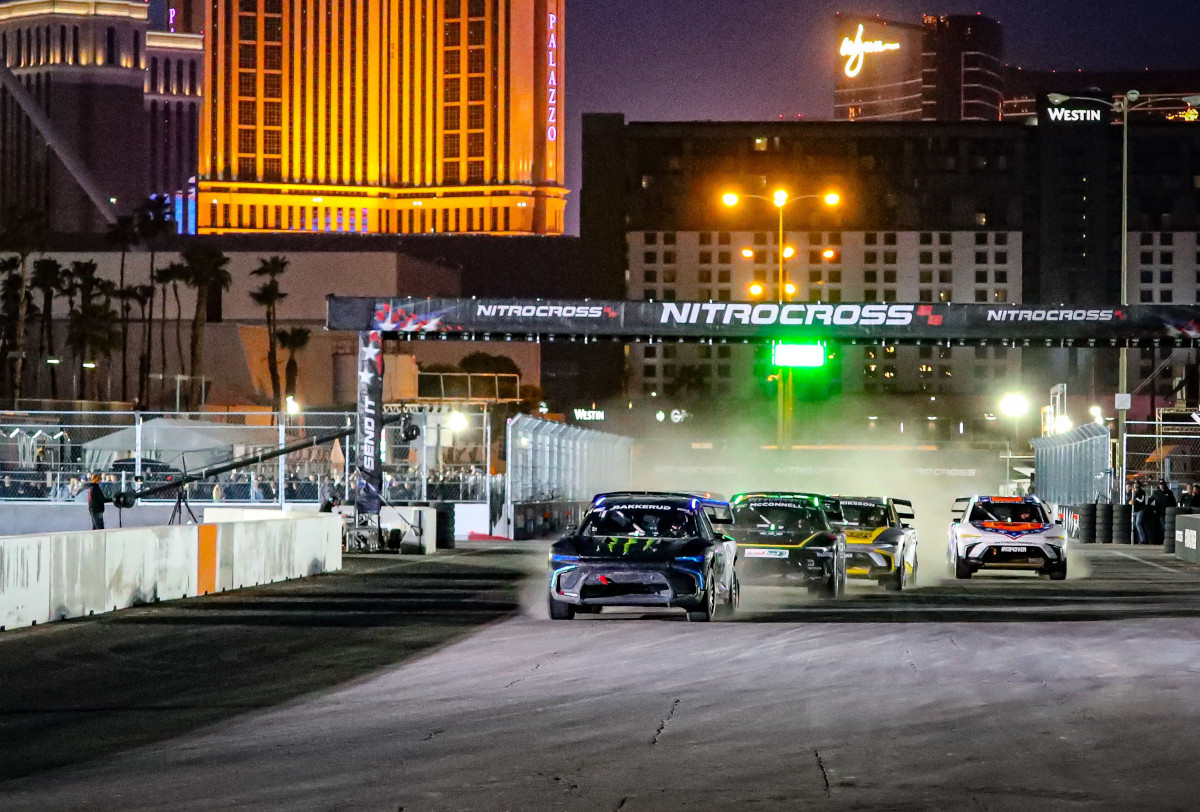David Ragan knew he was in a different kind of race car from the minute he pulled out of the garage.
“I learned how to drive a manual at probably the age of 6 or 7 years old on my grandfather’s tractor and this EV car, you put it in reverse, it’s a paddle shifter, but there’s no gears,” Ragan said. “There is a forward and a reverse and you click it in reverse, and it goes. You don’t have a clutch. You don’t have that sensation of choking the car down, getting it up to rpm or leaving the garage stall. It just goes.”
[lawrence-related id=360878]
Ragan has been the test driver of NASCAR’s battery electric vehicle, which was officially unveiled on Saturday in Chicago. In a partnership with ABB, the vehicle’s official name is the ABB NASCAR EV Prototype. It is shorter than the Next Gen car (193.4” to 185.5”) but weighs slightly more (3,485 lbs to 4,000 lbs).
The vehicle’s characteristics and energy saving make it ideal for short tracks and road courses. Martinsville Speedway, a half-mile, was one of the places Regan spent the most time behind the wheel.
“Martinsville is a track where you do a lot off feel and sound on the engine,” Ragan said. “Getting into the corner, you can often tell how fast you’re rolling based off engine deceleration. Leaving the corner, when you blend up to the wall, you don’t always look to the right to see how close you are (because) you can almost hear it. The closer you get to the wall that engine tune changes because of our exhaust coming out of the side of the car bouncing off the wall.
“I didn’t have any of that. So, I had to be a lot more conscious down the straightway looking and making sure I was using the whole racetrack.”
Ragan started driving stock cars in the NASCAR national series in 2004. He has nearly 600 starts between the Xfinity Series and Cup Series — all in a vehicle with an internal combustion engine.
The vehicle Ragan has driven in testing is all-wheel drive with three STARD UHP 6-Phase motors (one in the front, two in the rear) supplying power directly to the tires. The tunable powertrain can produce 1,000 kW at peak power and is anchored by a 78-kWh liquid-cooled battery.
“I can’t emphasize enough the regeneration capabilities. When you apply the brakes, it is sending some of that energy through the braking system back through a charger to the battery,” Ragan said. “So that helps the car slow down. We could tune that regen to very, very aggressive where I hardly had to touch the brakes, and that car would stop on a dime.
“That was hard for me to get used to because you just find that finesse with your left foot to roll into the corner, and if you rolled a little too fast, you could just gently apply a little bit of brake pressure in a traditional car and find that speed to roll the center. But with this car, it was a little more difficult to find that roll speed because the brakes were so efficient.”
 The list of differences goes on for quite a while. Ragan said there are about 15 buttons on the steering wheel (like those used in open-wheel racing) for a driver to adjust torque and other items. Another big difference was in the noise. The lack of engine noise meant Ragan could hear other noises that he wasn’t used to hearing in competition, such as tire squeals or chatter. Usually, a driver would feel that either in the steering wheel or through the seat.
The list of differences goes on for quite a while. Ragan said there are about 15 buttons on the steering wheel (like those used in open-wheel racing) for a driver to adjust torque and other items. Another big difference was in the noise. The lack of engine noise meant Ragan could hear other noises that he wasn’t used to hearing in competition, such as tire squeals or chatter. Usually, a driver would feel that either in the steering wheel or through the seat.
“But you could literally hear it and that was just weird,” Ragan said. “Your mind starts thinking about what you hear versus what you’re feeling. So, a lot of those little things I had to think about a little bit more.”
Because he is no longer a full-time driver, Ragan had the time and the interest to drive the EV. The adjustment Ragan went through driving it would be the same for any driver who got behind the wheel. But for now, NASCAR continues to stress there are no plans for a new series.
“It would be as big of a step as going from our old-style car to the Next Gen car,” Ragan said. “You hear drivers like Jimmie Johnson, who had been out of it a little and stepped back in, there are different cues that you’ve always thought of and relied on driving different types of cars that you were accustomed to feeling.
“Some drivers have struggled more than others finding that sweet spot and that edge that makes a great race car driver. So, it’s as big of a step or bigger driving this EV car because that edge feels different, and you have different propulsion capabilities and what it feels like when you do touch the brakes. It would be another adjustment.
“The best race car drivers can adjust. … But it is a big difference, for sure.”



